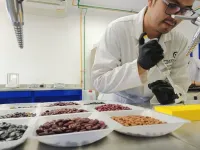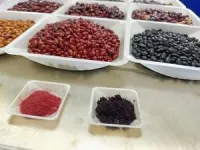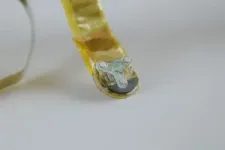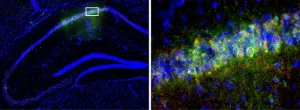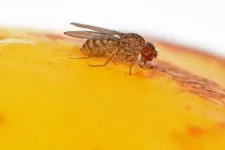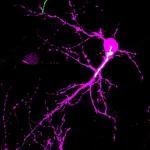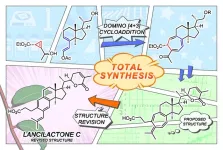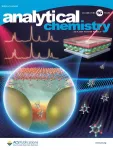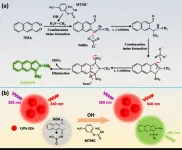(Press-News.org) URBANA, Ill. – Common beans are important food sources with high nutritional content. Bean seeds also contain phenolic compounds, which have antioxidant and anti-inflammatory properties that promote health. A study from the University of Illinois Urbana-Champaign and CIATEJ in Guadalajara, Mexico, explored the composition of seed coat extracts from black and pinto bean varieties unique to the Chiapas region of Southern Mexico.
“These beans are preserved among Mayan communities and grown by indigenous farmers. They are heirlooms from past generations and are important because of their cultural significance and contribution to biodiversity,” explained study co-author Elvira de Mejia, professor in the Department of Food Science and Human Nutrition (FSHN), part of the College of Agricultural, Consumer and Environmental Sciences (ACES) at U. of I.
The research team selected two varieties among several collected in the Chiapas region because of their high phenolic content, present in the seed coat pigment that gives the beans their dark red or black coloring.
“These phenolic compounds have the capability of keeping oxidation and inflammation under control, which could help decrease the risk of chronic health issues such as cardiovascular disease, cancer, and diabetes,” de Mejia said.
First, the researchers removed the bean seed coat and ground it for processing. Then they analyzed the chemical composition of a crude extract, as well as an enriched extract that was purified to concentrate the phenolic content. They also measured the bean extracts’ antioxidant capacity and ability to inhibit free radicals through biochemical assays and in silico molecular docking, a type of computer simulation.
“We found the black beans had high quantities of anthocyanin, in particular delphinidin, petunidin, and malvidin glucosides, which have antioxidative properties. The pinto beans had the highest total content of phenolic compounds and showed great potential for inhibiting enzymes that contribute to inflammation,” said David Fonseca Hernández, a doctoral student at CIATEJ, and lead author of the paper. Fonseca conducted the research as a visiting scholar in FSHN at U. of I.
The seed coat extracts can be used as additives in the food industry or in cosmetics, Fonseca explained.
“My research focuses on skin health, because there is a lot of interest in new ingredients with bioactive properties to use in formulations for creams. One of the main issues with aging skin is the oxidative stress that results from environmental factors. When the skin is exposed to air pollution and sunlight, it produces higher quantities of free radicals and inflammation pathways are activated,” he stated.
“We tested some markers related to inflammation, such as cyclooxygenase and inducible nitric oxide synthase. We had really good results showing the extracts, especially from pinto beans, could inhibit and reduce the activity of these enzymes.”
The researchers also found that the process of enriching the extracts can further concentrate the anthocyanins and phenolic compounds, which is useful both for industry and research purposes.
The study is part of a large project supported by CONAHCYT, Mexico’s National Science Foundation, explained study co-author Luis Mojica, research professor at CIATEJ and Fonseca’s advisor.
“One of the project’s goals was to find cultivars with an interesting profile to be used as a source of phytochemicals for the cosmetic industry. This industry is growing very fast, and there is a demand for natural products to treat skin-related diseases or aging,” he said. “In our research, we compared around 60 cultivars of common beans from the south of Mexico, and these two varieties are three or four times higher than others in phenolic compounds and anthocyanins. These beans are very interesting for health; they are also high in other nutrients such as proteins, fiber, and oligosaccharides.”
The project can help provide regional support by increasing wellness and developing Mexico’s southern region by preserving these unique bean varieties, the researchers stated.
Following up on the study’s significant laboratory findings, the next steps will be to test the extracts on cell tissue cultures and eventually in clinical trials.
Fonseca attended the U. of I. through I-MMAS, a program created to increase recruitment of Mexican and Mexican-American students within the University of Illinois System.
“Our collaboration with Dr. Mojica’s research group through I-MMAS is meaningful because there is a large number of migrants from Guadalajara in Illinois, but also because of the quality of their work. Dr. Mojica’s lab conducts basic research, but they also work with industry to apply the knowledge to solve practical problems. Dr. Mojica completed his doctorate degree in FSHN at U. of I. Both he and David were very productive and successful students during their time here, and we are very happy to continue our work with them,” de Mejia concluded.
The paper, “Black and pinto beans (Phaseolus vulgaris L.) unique mexican varieties exhibit antioxidant and anti-inflammatory potential,” is published in Food Research International [DOI: 10.1016/j.foodres.2023.112816]. Authors are David Fonseca Hernández, Luis Mojica, Mark A. Berhow, Korey Brownstein, Eugenia Lugo Cervantes, and Elvira Gonzalez de Mejia.
Funding for this research was provided by the Consejo Nacional de Humanidades Ciencias y Tecnologías CONAHCYT-Mexico, number 901000 and FORDECYT grant number 292474, and by the U.S. Department of Agriculture, Agricultural Research Service.
The College of Agricultural, Consumer and Environmental Sciences (ACES) at the University of Illinois has top-ranked programs, dedicated students, and world-renowned faculty and alumni who are developing solutions to the world’s most critical challenges to provide abundant food and energy, a healthy environment, and successful families and communities.
END
Unique Mexican black and pinto bean varieties are high in healthy compounds
2023-07-28
ELSE PRESS RELEASES FROM THIS DATE:
Circadian clock gene helps mice form memories better during the day
2023-07-28
A gene that plays a key role in regulating how bodies change across the 24-hour day also influences memory formation, allowing mice to consolidate memories better during the day than at night. Researchers at Penn State tested the memory of mice during the day and at night, then identified genes whose activity fluctuated in a memory-related region of the brain in parallel with memory performance. Experiments showed that the gene, Period 1, which is known to be involved in the body’s circadian clock, is crucial for improved daytime memory performance.
The research demonstrates a link between the circadian system and memory formation ...
Neonatal stem cells from the heart could treat Crohn’s disease
2023-07-28
Research from Ann & Robert H. Lurie Children’s Hospital of Chicago found that direct injection of neonatal mesenchymal stem cells, derived from heart tissue discarded during surgery, reduces intestinal inflammation and promotes wound healing in a mouse model of Crohn’s disease-like ileitis, an illness marked by chronic intestinal inflammation and progressive tissue damage.
The study, published in the journal Advanced Therapeutics, offers a promising new and alternative treatment approach that avoids the pitfalls of current Crohn’s disease medications, including diminishing effectiveness, ...
China, Indonesia, and Vietnam lead global growth for coming decade in new Harvard Growth Lab projections
2023-07-28
Cambridge, MA – China, India, Indonesia, Uganda, and Vietnam are projected to be among the fastest-growing economies for the coming decade, according to researchers at the Growth Lab at Harvard University. The new growth projections presented in The Atlas of Economic Complexity include the first detailed look at 2021 trade data, which reveal continued disruptions from the uneven economic recovery to the global pandemic. China is expected to be the fastest-growing economy per capita, although its growth rate is smaller than gains seen over the past decade.
Growth over the coming decade is projected to take off in three growth poles, East Asia, Eastern ...
Researchers tickle rats to identify part of the brain critical for laughter and playfulness
2023-07-28
To study play behaviors in animals, scientists must be able to authentically simulate play-conducive environments in the laboratory. Animals like rats are less inclined to play if they are anxious or restrained, and there is minimal data on the brain activity of rats that are free to play. After getting rats comfortable with a human playmate, tickling them under controlled conditions, then measuring the rats’ squeaks and brain activity, a research team reports on July 27 in the journal Neuron that a structure in rat brains called the periaqueductal gray is essential for play and laughter.
“We know that vocalizations such as laughter are very ...
Scientists discover secret of virgin birth, and switch on the ability in female flies
2023-07-28
Scientists have pinpointed a genetic cause for virgin birth for the first time, and once switched on the ability is passed down through generations of females.
For the first time, scientists have managed to induce virgin birth in an animal that usually reproduces sexually: the fruit fly Drosophila melanogaster.
Once induced in this fruit fly, this ability is passed on through the generations: the offspring can reproduce either sexually if there are males around, or by virgin birth if there aren’t.
For most animals, reproduction is sexual - it involves a female’s egg being fertilised by a male’s sperm. ...
Uncovering how the Golgi apparatus impacts early postnatal neuron development
2023-07-28
Neurons are the cells that constitute neural circuits and use chemicals and electricity to receive and send messages that allow the body to do everything, including thinking, sensing, moving, and more. Neurons have a long fiber called an axon that sends information to the subsequent neurons. Information from axons is received by branch-like structures that fan out from the cell body, called dendrites.
Dendritic refinement is an important part of early postnatal brain development during which dendrites are tailored to make specific connections with appropriate axons. In a recently published paper, researchers present evidence showing how a mechanism within the neurons of a rodent involving ...
Total recall on HIV
2023-07-28
Kyoto, Japan -- Having control over how a dish is cooked is always a good idea. Taking a hint from the kitchen, scientists appear to have discovered a way to produce a true structure of the rare but naturally-occurring anti-HIV compound Lancilactone C from start to finish.
Its non-cytotoxicity in mammals could make this triterpenoid an ideal candidate for treating AIDS if its biological activity were clear -- and if only it were abundant in nature.
Now, a research group at Kyoto University has succeeded in ...
Scientists suggest AgNP/MoS2 nano-pocket for surface-enhanced raman spectroscopy scattering detection
2023-07-28
The research group of YANG Liangbao at the Institute of Health and Medical Technology, Hefei Institutes of Physical Science (HFIPS), Chinese Academy of Science (CAS) has recently developed a surface-enhanced Raman spectroscopy (SERMS) method to automatically capture target molecules in AgNP/MoS2 nano-pockets, which enables highly sensitive and long-duration dynamic detection of some chemical reaction processes.
The results were published in Analytical Chemistry and selected as the front cover.
Surface-enhanced Raman spectroscopy (SERS) is a kind of molecular spectroscopy with fast, highly sensitive, ...
Solving the climate crisis requires collaboration between natural and social scientists
2023-07-28
Now that the world has experienced its hottest day in history, it is more urgent than ever for natural and social scientists to work together to address the climate crisis and keep global temperature increases below 2°C. To this end, an international group of esteemed researchers recently published an innovative research paper that highlights the importance of integrating knowledge from natural and social sciences to inform about effective climate change policies and practice. They argue that the concept of tipping points can serve as a bridge ...
A nanoprobe developed for visual quantitative detection of pesticides
2023-07-28
Recently, Prof. JIANG Changlong and his research team at the Institute of Solid State Physics, Hefei Institutes of Physical Science (HFIPS) of Chinese Academy of Sciences (CAS), developed and synthesized two highly effective ratiometric fluorescence nanoprobes. These nanoprobes, when combined with the color recognition capabilities of smartphones, enabled the visual and quantitative detection of pesticides in food and environmental water.
The research has been published in Chemical Engineering Journal and ACS Sustainable Chemistry & Engineering.
Carbamate compounds ...
